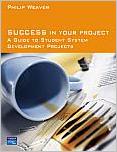| |||||
• polskie
• Zamów informacje o nowościach z wybranego tematu • kontakt |
SUCCESS IN YOUR PROJECTWEAVER P.wydawnictwo: FT/PH, 2004, wydanie Icena netto: Final year projects are an important feature of most undergraduate and postgraduate degrees in the fields of Business Information Technology, Information Systems, Software Engineering and Business Computing. These projects usually involve students in the practical application of theory together with a critical analysis or evaluation of the excecution of their project or of the theory applied.
Structure of the book is chronological, covering project preparation, project execution and project completion. Examples of each key product and activity are included as are examples of different types of project, using the three main system development methodologies, SSADM, UML and DSDM. A website with templates and examples is available for students. Table of Contents Part 1 - Project preparation and set-up Chapter 1 - Introduction to student projects What is a project? Types of projects Business and information systems strategy Feasibility Studies Complex software development Multi-media projects Technical infrastructure projects Research projects and case studies Hybrid projects Group projects Critical success (and failure) factors Assessment criteria (what makes a great project)
Sources of projects Generating ideas Selection criteria Short-listing and modifying ideas Examples of past projects Making the final selection
The System Development Life Cycle (SDLC) Project phases and organisation Structured methods Object-oriented methods Rapid Application Development (RAD) Other methodologies Package implementations
Getting organised Project objectives (academic and business) and scope definition Project deliverables Selecting the development method Research questions Initial planning The roles of the project supervisor, student and client Producing a project proposal
Chapter 5 - Project Management. Detailed planning Time management Record keeping and good housekeeping Project tracking and control Tools and techniques Risk and issue management Common problems and their management Controlling change Progress reporting Using the project supervisor Managing the client Project teams
Types of research Literature sources and searches Writing a literature review Research methods Primary and secondary data, and its collection Analysing data
Fact finding Workshops Recording requirements Modelling requirements Early prototypes Package research and selection Technical requirements Feasibility Studies Project management and reporting
Identifying, evaluating and selecting system solutions Conceptul design Data analysis Physical design Human-computer interaction Prototyping Data management design Technical design Design prototypes Project management and reporting
Program or component specification Software production and programming Incremental delivery Package configuration Testing and de-bugging Data conversion and preparation User and system documentation Software installation Technical infrastructure implementation Maintenance Project management and reporting
(50-60 pages)Chapter 10 - Critical analysis and evaluation Review of objectives and theory Analysis of the development process Evaluating alternative approaches Evaluating the final deliverables and research results
Poster presentations Preparing and presenting papers Draft reports Report structure, content and presentation Report writing Common errors Referencing Plagiarism and data protection Software demonstrations Viva voce examinations
(20-30 pages)Appendix A - Glossary Appendix B - Bibliography Appendix C - Checklist 290 pages Księgarnia nie działa. Nie odpowiadamy na pytania i nie realizujemy zamówien. Do odwolania !. |


